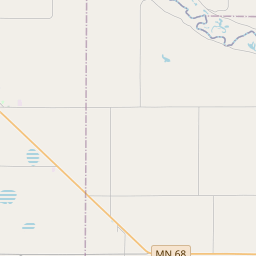A Minority in Their Homeland / U.S.-Dakota Conflict
Historical marker location:
72404 County State Aid Highway 30, Fairfax, Minnesota
( Marker can be reached from County Highway 30, 1.1 miles west of State Highway 4, on the right when traveling west.)







© OpenStreetMap contributors
The first successful commercial shipment of wheat from the Great Plains to Europe was made in 1871 from Minneapolis.
About Nicollet County
Nicollet County Timeline
Nicollet County, located in southwestern Minnesota, has a rich and diverse history that dates back thousands of years. The area was originally inhabited by various Native American tribes, including the Dakota Sioux. These indigenous people lived off the land, engaging in farming, hunting, and trading.
In the early 19th century, European settlers began arriving in the region, attracted by the fertile soil and potential for agricultural development. The township of Traverse des Sioux, located in present-day Nicollet County, emerged as an important trading post for fur traders and indigenous peoples. In 1851, the Traverse des Sioux Treaty was signed, ceding Native American land to the United States government and paving the way for further settlement.
Nicollet County was officially established on March 5, 1853, named after French explorer Joseph Nicollet. The county's first European settlers engaged in farming, primarily growing wheat, corn, and oats. As the region developed, small towns and villages such as St. Peter, North Star, and Lafayette sprang up, serving as centers of commerce and community for the local population.
Over the years, Nicollet County has seen significant growth and progress. The establishment of railroads in the late 19th century connected the county with larger markets, boosting economic opportunities. The county's economy thrived, with the agricultural sector expanding and the introduction of industrialization contributing to its prosperity. Today, Nicollet County continues to evolve, combining its rich history with modern developments and a strong sense of community.
In the early 19th century, European settlers began arriving in the region, attracted by the fertile soil and potential for agricultural development. The township of Traverse des Sioux, located in present-day Nicollet County, emerged as an important trading post for fur traders and indigenous peoples. In 1851, the Traverse des Sioux Treaty was signed, ceding Native American land to the United States government and paving the way for further settlement.
Nicollet County was officially established on March 5, 1853, named after French explorer Joseph Nicollet. The county's first European settlers engaged in farming, primarily growing wheat, corn, and oats. As the region developed, small towns and villages such as St. Peter, North Star, and Lafayette sprang up, serving as centers of commerce and community for the local population.
Over the years, Nicollet County has seen significant growth and progress. The establishment of railroads in the late 19th century connected the county with larger markets, boosting economic opportunities. The county's economy thrived, with the agricultural sector expanding and the introduction of industrialization contributing to its prosperity. Today, Nicollet County continues to evolve, combining its rich history with modern developments and a strong sense of community.
Nicollet County Timeline
This timeline provides a condensed summary of the historical journey of Nicollet County, Minnesota.
- 1853: Nicollet County is established on March 5.
- 1854: The county's first courthouse is built in Traverse des Sioux.
- 1857: St. Peter becomes the county seat.
- 1862: The Dakota War of 1862 leads to conflict between settlers and the Dakota Sioux.
- 1866: The county's second courthouse is built in St. Peter.
- 1875: The State Asylum for the Insane, now known as the Minnesota Security Hospital, is established.
- 1878: Gustavus Adolphus College is founded in St. Peter.
- 1893: The county's third courthouse is completed in St. Peter.
- 1904: The St. Peter State Hospital opens, later renamed the St. Peter Regional Treatment Center.
- 1949: The construction of the Minnesota River Valley Scenic Byway begins.
- 1956: Floodwaters from the Minnesota River cause significant damage in St. Peter.
- 1998: A tornado strikes St. Peter, causing extensive damage.